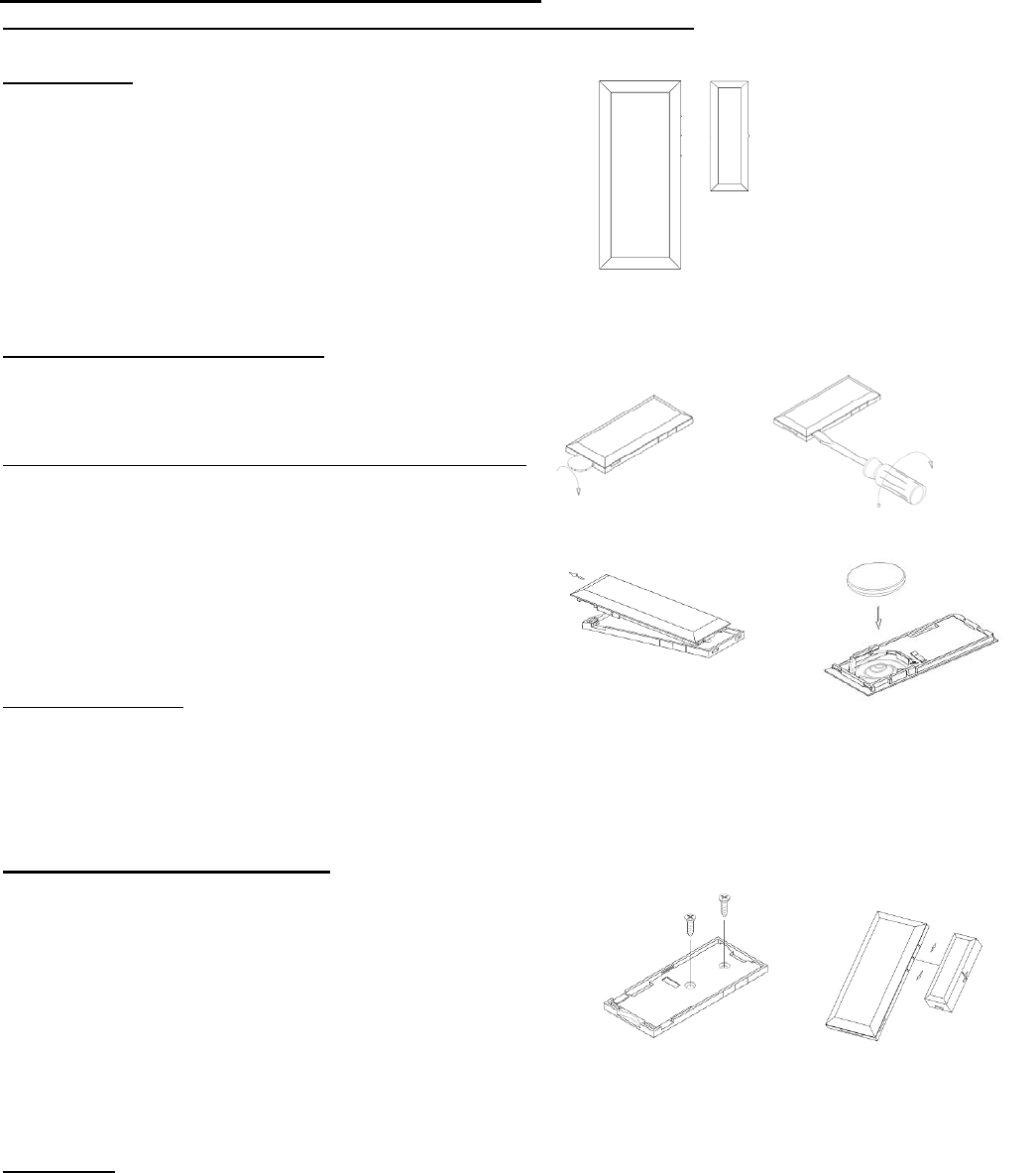Secure Wireless EV-DW4975 Vanishing Door/Window Sensor User Manual EV DW4975 user
Secure Wireless, Inc Vanishing Door/Window Sensor EV DW4975 user
Users Manual

EV-DW4975 Vanishing Door/Window Contact- Installation Manual
Introduction
The EV-DW4975 is the industries thinnest supervised
door/window contact allowing a multitude of
applications while hiding the transmitter on a door or
window frame. The EV-DW4975 uses a replaceable
lithium battery and should last 5 years under normal
usage.
Install or Replacing the Battery
The EV-DW4975 uses a Panasonic CR2032 Lithium
Battery and is shipped not installed to save battery life.
Follow the steps below to install or replace the battery.
1) Using a coin (Figure 1) or a flat head screw driver
(Figure 2) insert into the notch located on the case and
gently twist to open. Lift up and pull the case outward
to open (Figure 3).
2) Insert Battery (figure 4) + side facing UP.
Use care when installing the battery and observe the
correct polarity when the battery is inserted . Use only
Panasonic Lithium CR2032 batteries for replacement.
WARNING!: Battery may explode if mistreated. Do not
recharge, disassemble or dispose of in fire.
Mount Transmitter and Magnet
1)Mount the EV-DW4975 on any window or door
frame using the supplied double strick tape or screws
(Figure 5).
2) Find the notch on the outside of the EV-DW4975
enclosure. Align the manget with the nothces and
ensure that the distance is no greater than 5/8 of an inch
(Figure 6)
Enrolling
Refer to your installation manual for enrolling wireless
devices into a DSC control panel.
Figure 1
Figure 2
Figure 3 Figure 4
Figure 5 Figure 6

Temperature Specifications:
The EV-DW4975 is not design to be placed in an
environment where the temperature drops below -10C
or goes above +50C. Temperatures below -10C can
cause the EV-DW4975 to falsely report a low battery
after a few years of service. As the battery depletes over
time the internal impedance is lowed and at extreme
temperatures below -10C can cause a false positive. If
you choose to use the EV-DW4975 in an environment
below -10C, the battery life can be reduced to as little
as 3 years instead of the specified 5 years of life.
FCC/IC Compliance Statement:
Any changes or modifications not expressly approved by the party
responsible for compliance could void the user's authority to operate the
equipment.
This equipment has been tested and found to comply with the limits for a Class B
digital device, pursuant to part 15 of the FCC Rules. These limits are designed to
provide reasonable protection against harmful interference in a residential
installation. This equipment generates, uses and can radiate radio frequency energy
and, if not installed and used in accordance with the instructions, may cause
harmful interference to radio communications. However, there is no guarantee that
interference will not occur in a particular installation. If this equipment does cause
harmful interference to radio or television reception, which can be determined by
turning the equipment off and on, the user is encouraged to try to correct the
interference by one or more of the following measures:
—Reorient or relocate the receiving antenna.
—Increase the separation between the equipment and receiver.
—Connect the equipment into an outlet on a circuit different from that to which the
receiver is connected.
—Consult the dealer or an experienced radio/TV technician for help
This device complies with part 15 of the FCC Rules. Operation is subject to
the following two conditions: (1) This device may not cause harmful
interference, and (2) this device must accept any interference received,
including interference that may cause undesired operation.